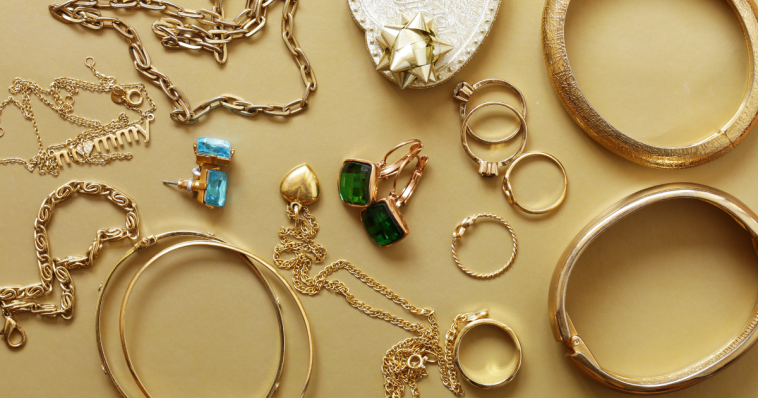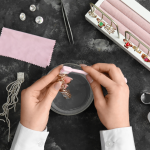Wearing jewelry is a fun and excellent way to improve one’s outfit and showcase your style, whether adding sparkle or sophistication. It’s the perfect finishing touch that makes you feel confident and complete. However, for some people, this pleasure can quickly turn into discomfort. Imagine slipping on a beautiful pair of earrings, only to find that your earlobes start itching within hours, or wearing a necklace that leaves an irritating rash on your neck. These reactions can sometimes occur suddenly after the first contact or develop slowly over time with repeated wear.
Regardless of when the irritation begins, the likely cause is a metal allergy. This condition happens when your skin reacts adversely to metals commonly found in jewelry. It’s common for these allergic reactions to trigger symptoms from mild redness and itching to more severe swelling and rashes. Understanding that these issues are often caused by metals like nickel, prevalent in many jewelry pieces, can help you make better choices. Opting for hypoallergenic jewelry can be a game-changer, ensuring you enjoy your accessories without the discomfort of allergic reactions.
What is a Metal Allergy?
A metal allergy, known as contact dermatitis, is a skin condition where your body reacts adversely to certain metals, often found in everyday jewelry. If you’ve ever noticed an itchy red rash shortly after putting on a necklace, bracelet, or pair of earrings, you might be experiencing this type of allergy. The reaction can go from mild to severe, with symptoms such as swelling, blisters, and red marks precisely where the jewelry touches your skin. You might also notice dry patches or a warm sensation in the affected area.
When someone with a metal allergy comes into contact with the offending metal, their immune system mistakenly identifies it as harmful. In response, the body releases histamine, a chemical that causes inflammation and the uncomfortable symptoms you experience. This reaction can occur immediately after contact or develop gradually with repeated exposure. While it can be frustrating, understanding that your skin’s response is your body trying to protect itself can help you take the necessary steps to prevent future reactions.
Nickel Allergies
Nickel is one of the most generally used metals in jewelry but is also the leading cause of metal allergies. This metal is often mixed with others to create alloys found in everything from earring posts and body jewelry to costume pieces. Unfortunately, about 20% of the U.S. population is allergic to nickel, with women and children particularly susceptible. This allergy can develop at any point in life; once it does, it usually sticks around. If you have a nickel allergy, you’ll likely experience symptoms whenever you come into contact with metal items. That’s why choosing hypoallergenic jewelry is essential for those affected, helping to prevent uncomfortable reactions and allowing you to enjoy wearing your favorite pieces without worry.
What is Hypoallergenic Jewelry?
Hypoallergenic jewelry is intended to reduce the chance of allergic reactions, making it an excellent deal for sensitive skin or metal allergies. The term “hypoallergenic” means that the jewellery is created from materials less likely to trigger irritation or allergies. This is typically achieved by using metals free from common allergens, such as nickel, which is known to trigger skin reactions in many people. Popular hypoallergenic options include sterling silver, platinum, gold, and titanium, all known for their reduced risk of causing discomfort.
Choosing hypoallergenic jewelry can significantly enhance your wearing experience, allowing you to enjoy your accessories without worrying about itching, redness, or swelling. These pieces are gentle on the skin and durable and stylish. By opting for jewelry marked as hypoallergenic, you can ensure that your accessories remain beautiful and comfortable, making them a practical and thoughtful choice for those with sensitive skin or allergies.
The Best Hypoallergenic Metals for Jewelry
Sterling Silver
Silver alone is hypoallergenic, but its pure form is too soft to wear daily. That’s where sterling silver comes in. Sterling silver combines 92.5% pure silver with 7.5% other metals, typically copper, enhancing its strength and durability for jewelry. With copper, silver is more durable while maintaining its hypoallergenic properties. When choosing sterling silver jewelry, ensure it does not contain nickel, as nickel can typically trigger allergic reactions. Opt for pieces stamped with .925, which indicates they are made of high-quality and pure silver. Moreover, it makes them an elegant choice for sensitive skin.
Platinum
Platinum is one of the safest and perfect metals for those with known allergic reactions. It consists of 95% pure platinum and 5% iridium, which makes it very improbable to cause allergic reactions. Its composition guarantees incredibly hypoallergenic, reassuring those with sensitive skin.
In addition to being mild on the skin, platinum is noted for its durability, making it an excellent option for day-to-day wear. It maintains its shine and resists tarnishing, ensuring your jewelry will always look pristine. However, platinum is one of the more expensive metals due to its high purity and durability, so adding even a few pieces to your jewelry collection can be a considerable investment.
Gold
Gold is an excellent choice for hypoallergenic jewelry, though, like silver, it is too delicate in its purest form to be suitable for everyday use. Gold is usually mixed with other metals to make it more durable and practical. The most common standard is 14K gold, where 14 24 karats are pure gold, while the remaining ten karats consist of other metals, often copper or silver.
Despite the alloying, high-quality gold jewelry minimizes the risk of allergic reactions for most people. The other metals used are carefully chosen to guarantee compatibility with sensitive skin, making 14K gold a reliable pick for those who value elegance and hypoallergenic qualities.
Titanium
Titanium is a favored choice for hypoallergenic jewelry, but it is pretty soft in its pure form, like gold and silver. To make it suitable for everyday wear, titanium is typically alloyed with other metals such as aluminum, tin, and vanadium. This process improves its stability and durability, making it more robust and suitable for jewelry use.
One of titanium’s advantages is that it does not contain nickel, so it’s an excellent choice for people with sensitive skin. Additionally, titanium is much lighter than gold and silver, making it a more affordable pick. However, it’s worth mentioning that titanium rings and pieces cannot be resized and may be prone to scratching over time. Despite having these drawbacks, titanium remains a strong and budget-friendly alternative to traditional metals.
Benefits of Hypoallergenic Jewelry
Hypoallergenic jewelry offers significant advantages for those with sensitive skin or metal allergies. One of the primary benefits is the reduced risk of allergic reactions. By avoiding common irritants like nickel, hypoallergenic jewelry minimizes the likelihood of itching, redness, or swelling, providing a more comfortable wearing experience. This makes it an excellent choice for individuals who struggle with metal allergies or skin sensitivities, allowing them to enjoy their jewelry without discomfort.
In addition to being gentle on the skin, hypoallergenic jewelry is known for its durability and low maintenance. Metals such as titanium and platinum, commonly used in hypoallergenic pieces, are resistant to tarnishing and wear, ensuring that your jewelry stays in excellent condition over time. This durability means hypoallergenic jewelry looks pristine and withstands daily wear and tear. With many styles available, hypoallergenic options offer aesthetic appeal and practical benefits, making them a versatile and reliable choice for any jewelry collection.
How to Choose Hypoallergenic Jewelry
When selecting hypoallergenic jewelry, start by checking the materials used. Look for jewelry marked as hypoallergenic and specifically free of nickel, a common irritant. Opt for metals like titanium, platinum, or sterling silver, which are less likely to cause allergic reactions. For earrings, ensure that the posts and the earrings are made from hypoallergenic materials to avoid irritation.
Additionally, it’s essential to consider the brand’s or jeweler’s reputation. Trusted sources will offer detailed information about the metal composition and any testing to verify hypoallergenic properties. While hypoallergenic jewelry may have a higher price tag, reduced skin irritation and lasting durability make it a worthwhile investment. By choosing carefully, you can enjoy your jewelry comfortably and with confidence.
Wearing jewelry is a fun and stylish way to complete any outfit and express yourself. But for some, the enjoyment can quickly turn to discomfort due to metal allergies. If you’ve ever had an earring that made your earlobes itch or a necklace that left a rash, you know how frustrating it can be. These reactions can happen immediately or develop over time, and they’re often caused by metals like nickel, commonly used in jewelry.
A metal allergy, or contact dermatitis, happens when your skin reacts to certain metals in jewelry. Symptoms of a metal allergy can vary from mild redness and itching to more severe issues like swelling and blistering. Nickel is a common offender, and many people are sensitive to it. Choosing hypoallergenic jewelry from platinum, titanium, or high-quality sterling and gold can help avoid these issues. These metals are less likely to trigger skin irritations or allergic reactions, providing a more comfortable wearing experience. By selecting jewelry designed to be gentle on sensitive skin, you can enjoy your accessories without worrying about irritation, making your style beautiful and comfortable.



